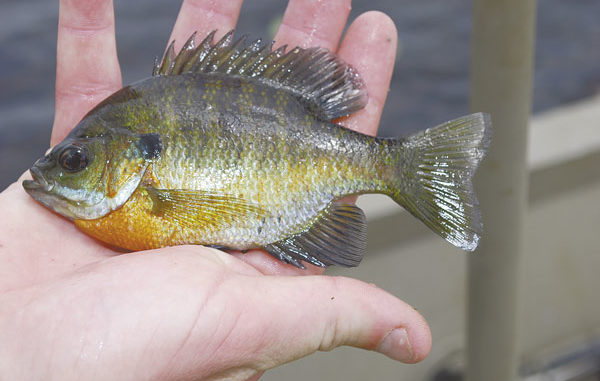
Red snapper rise to chum and make catching a breeze in South Timbalier 100 field.
Bluegills are a member of the sunfish family, Centrarchidae. The two largest members of the family are largemouth black bass and spotted black bass. Probably the most popular family members, certainly amongst fish eaters, are the black and white crappie.
Besides the oddball shadow bass and the banded pygmy sunfish, the other 10 Louisiana members of the family are sunfish, collectively called bream (pronounced “brim”) or perch (humorously mispronounced “poich”). The most common of these and the most popular with fishermen are bluegills.
Bluegills are spunky, hard-fighting and very willing to take a baited hook. On their spawning beds (they are nest-spawners), large males can be incredibly colorful, with purplish-brown heads, cyan lower jaws and gill covers and bright copper bellies and flanks. Mature females, at best can be called drabber, with yellow bellies and vertically barred olive and silvery-yellow flanks.
Although sometimes arrogantly dubbed “kid’s fish” by bass elitists, true bluegill fishing specialists know better. Finding and catching big bluegills consistently is challenging. And the rewards — on the table — are great.
Unfortunately, bluegills have a reputation for “stunting,” having a strong population of small fish, rather than the big 8-inch-plus fish so desirable to anglers. Both fishermen and biologists have long assumed that stunting was due to too many bluegills being present in a water body for the food supply.
In response, biologists usually recommended fishing bluegills harder to “thin them out” and make room for larger fish. Biologists have also selectively poisoned them, added more predator fish to the population and even tried to feed them. Sometimes these tactics worked; often they didn’t.
More recent research indicates that too much fishing pressure on bluegills, rather than too little, may be one cause of stunting. Large male bluegills are easiest to catch in the warm summer months when they are concentrated on their spawning beds. A bed may have up to 500 individual nests in a small concentrated area. Each nest is about the size of a dinner plate, and is swept clear of silt and guarded by the male fish against other fish that may eat the eggs on the nest.
During the four-month spawning season, male bluegills will almost continuously be on their nests for repeated spawnings. While on the nest, a male is not able to forage for food and as a result will grow very little. The best nest sites are those in the center of the bed because egg-stealers will enter the colony from the edges and usually don’t make it to the center.
Male bluegills compete intensely for these best sites, and larger males usually win. In a population with a lot of large males, smaller males can’t compete and instead of becoming sexually mature, they delay maturation and feed and grow for another year.
If, however, large numbers of big males are removed from the nests by fishing, these younger, smaller males have less competition, start spawning and stop growing. The result is a stunted population, not because of slow growth, but because of early maturation.
In 1992 Texas biologists tried another approach to producing larger male bluegills — the use of minimum size limits. In Purtis Creek State Park Lake, bluegill catch rates were high, but few fish over 7 inches long were caught. That year, biologists placed a 7-inch minimum size limit in effect in the lake.
They expected bluegill harvests to fall right after the regulation was put in place, and then increase as smaller fish grew to larger sizes. The biologists sampled the fish population by electrofishing (shocking) for two years before the regulation and three years after. They also conducted creel surveys of the fishermen to get estimates of how much they fished, their catch rates and the size of the fish that they caught.
Surprisingly, bluegill sizes in the lake stayed very close to the same after the minimum size was put in effect, as compared to the pre-regulation period. Few fish over 7 inches were found. The bluegills in the lake showed rapid growth, but few of them lived over two years. Most interestingly, electrofishing found that the number of bluegills in the lake steadily declined from 1990 to 1995.
After the regulation, the amount of fishing for bluegills fell to 39 percent of what it was before the regulation. Harvests per hour per fisherman were 42 percent of what they were before. The 7-inch minimum size limit did cause the average weight of bluegills harvested to increase from 3 ounces to 5.4 ounces, but because of the large decrease in the number harvested, the total weight of bluegills harvested dropped to just over 11 percent of what it was.
The biologists concluded that it was not fishermen’s harvest that was the driving factor in high bluegill mortality in the lake, but rather natural mortality caused by how the lake’s largemouth bass were being managed. Bass regulations provided for only catch-and-release fishing. Under normal circumstances, many bluegills will live to age 5, and some will make it to 8 years old. In this lake, the large population of largemouth bass ate them so quickly that few survived to 3 years old or older.
The results of the study convinced the biologists that it was probably futile to attempt to manage for both large bluegills and large bass at the same time, and they recommended that the 7-inch rule be removed.


